
(SHELBY THEVENOT / iNFOnews.ca)
July 18, 2019 - 5:30 PM
KELOWNA - After years of increased homelessness and drug use in Kelowna, resources being poured into the system trying to resolve the crises are starting to pay dividends.
Corinne Dolman is the director of substance use for Interior Health, which received significant funding increases for treatment options in major Interior cities like Kamloops, Kelowna, Penticton and Vernon.
“I think there is reason to be optimistic, as long as the focus continues to be on building a comprehensive system of care for people, including the system of housing,” Dolman told iNFOnews.ca today, July 18. “If the trend we are in now continues, I think we will start to see significant decreases in the number of people who are homeless and engaging in public substance use and all the other things that concern people.”
The media focus over the past few months has been on supportive housing but some politicians have questioned whether there are enough treatment services to go with the housing. Those concerns are legitimate and long-standing, Dolman said.
“There hasn’t been a good system of care or a lot of attention in this area for many years,” she said. “When the move was made to having more community-based services, as opposed to a facility like Riverview (mental health institution), there weren’t enough resources put into the community to support that and that resulted in people ending up homeless and in much worse condition.”
While lots more needs to be done, the situation is improving as money has poured into things like the Opiate Agonist Treatment program where opioid users can get substitute drugs, such as methadone or suboxone, to help them either return to a more normal life while safely using or to get off the drugs altogether.
While there used to be waitlists of six to eight weeks to get into those programs, users can now usually get into treatment the same day. Plus, the requirement to take part in an orientation group has been dropped because that was a deterrent for some people.
There has also been an increase in the number of clinicians working with addicts and they are being trained to recognize and deal with things like mental health conditions that complicate or contribute to the addictions (or, as Dolman calls it, Substance Use Disorders).
There has not been an increase in the past few years in the number of full treatment beds. That’s not necessarily a bad thing as the focus has shifted, where possible, to things like day treatment options so people can continue to live in their own homes.
Besides, for people with opioid addictions, detoxing in a treatment centre without access to substitute drugs and programs can actually be dangerous.
When long-term opioid users quit, their tolerance levels decline.
“There is a lot of concern because for people coming out of a treatment bed then relapsing, the risk of death is really high,” Dolman said.
She stressed that housing is the first step for people to get into treatment
“It’s very difficult to work with people who are not housed and get them into services,” Dolman said. “It’s really quite remarkable what you see in some of these very low barrier services. Once people are stabilized and have things like their housing is taken care of … then they start to begin engaging in services.
“Everybody wants to be well. It’s really a matter of how we get people there. There’s lots of good evidence that shows that you start to work with people where they are, then you start to move them along the continuum.”
To contact a reporter for this story, email Rob Munro or call 250-808-0143 or email the editor. You can also submit photos, videos or news tips to the newsroom and be entered to win a monthly prize draw.
We welcome your comments and opinions on our stories but play nice. We won't censor or delete comments unless they contain off-topic statements or links, unnecessary vulgarity, false facts, spam or obviously fake profiles. If you have any concerns about what you see in comments, email the editor in the link above.
News from © iNFOnews, 2019